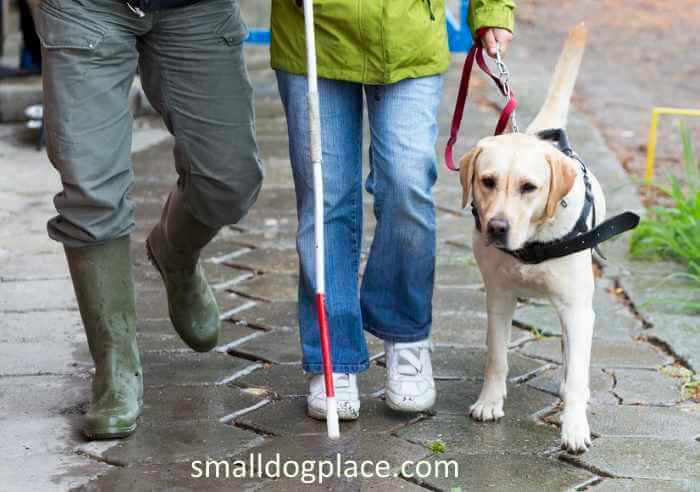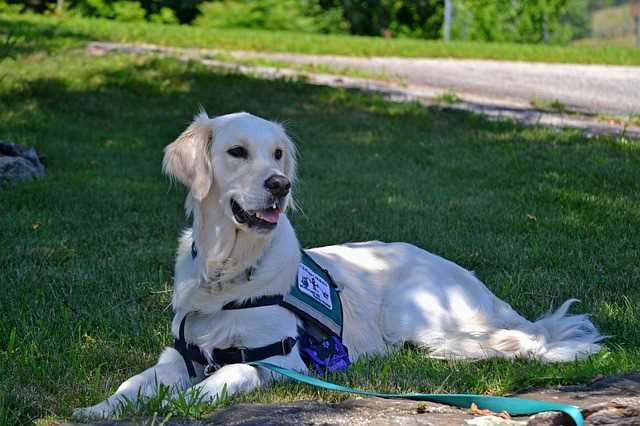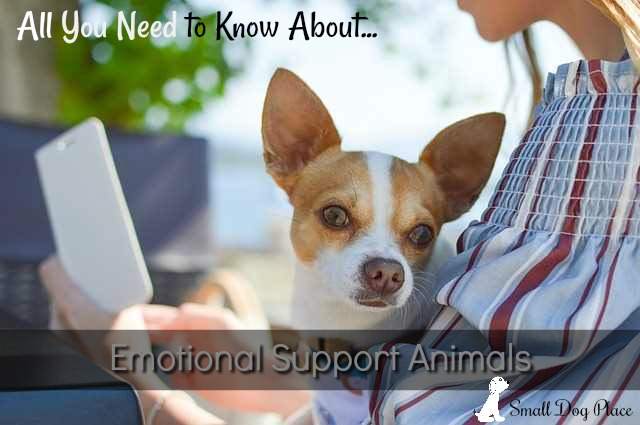- Small Dog Place Home
- Training
- Training Requirements for Service Dogs
Training Requirements for Service Dogs
Training Requirements for Service Dogs by Connor Tritton |Last Updated 12-08-2022
 Training Requirements for Service Dogs
Training Requirements for Service DogsDo you know the value of a service dog? Do you know the training requirements for service dogs? If not, This article will walk you through all the characteristics needed as well as training for service dogs.
Well, I can say that it is something valuable! A dog has been man’s loyal friend throughout the ages.
And, they have proved to be extremely helpful perhaps more than any other kind of pets. On top of this, some dogs provide professional assistance to folks, who need it. Their training is of utmost importance, so is their vaccination schedule.
If you were ever interested in service dogs, you must be aware of some of the benefits of service dogs. There is a step-by-step process to train a dog.
Breeds Best for Service Dogs
What breeds are best for Service Dogs?
Well, the answer is any dog! Yes, you read right, any dog can become a certified service dog.
That means, Golden Retrievers, Border Collins, German Shepherds, etc. are the common breeds given one can found for service dogs. Usually, a larger dog is required for physical assistance, while for emotional support a small dog is acceptable.
Qualities and Training Requirements for Service Dogs
Even if you know the basic
requirements needed for a dog to become a
service animal, let’s build your knowledge more.
Age and Health of the Dog
Firstly, assess the Age and Health
You all know the need for a veterinary hospital in a pet’s life. Therefore, every dog being trained for service purpose must be healthy.
Such dogs should not possess health problems like diabetes and arthritis that are responsible for putting the strain on the pets. An important point – all dogs should be neutered to make the male dogs less aggressive and help female dogs to bear the heat.
The Dog's Temperament
Second, test the Dog’s Temperament Traits.
The right temperament of a dog is necessary. Some dogs may get easily aggressive while others may not.
If a dog is cool and calm on the one hand, but smart and quick on the other hand, there are chances it can be a good service dog. Knowing a dog’s breed characteristics will play a key role.
Professional Training is a Must
Third, Training only
by a skilled professional is required.
Certain people do have a certified qualification and experience to train dogs, but it may not suit every dog.
Another thing to note is that not every country provides a certificate to the trainers, so, it is important to find a good and reputable trainer for your dog.
Training Requirements for Service Dogs
Fourth, consider the training requirements for service dogs.
The international standard is 120 hours a minimum over six months or more. While in the US there is such requirement, self-regulation is essential, and it is good to follow the guidelines. There are three phases:
Heeling
This is one of the most difficult parts. It involves maintaining the
relative position with the handler (human), regardless the moves of the
handler.
Proofing
This is sometimes considered to be the most consuming phase. In this, the dog is
trained to do all the required moves along with constant distractions.
Tasking
In this, they learn the particular task to be performed such as pulling a wheelchair or guiding a blind person. The training for this step is often said to be one of the easiest.
During these sessions, there should not be any
leniency in animal veterinary care, which will include dog’s
vaccinations and check-ups.
Training Requirements for Service Dogs: The Public Access Test
This step is important as it tests the training. Some of the basic test includes:
- Curbed excitement in dogs
- Surcease of sniffing behaviors of the dog
- Less or no solicitations for food or affection
Registration and Equipping
Registering the dog ensures the competency of the dog, and it (or you) might be questioned at some point in time.
These registered dogs are then used for various purposes, helping folks as and when needed.
Service dogs are trained for many purposes to improve the disabled person’s functionality.
An individual who is disabled in any manner can benefit from a dog who helps them lead a healthy life without much trouble.
Keeping track of wellness exams for pets is essential for building the health of the dogs.
Many service dogs have performed remarkably in helping humans with various tasks. In fact, it is truly inspiring how well they perform their act; I personally feel service dogs should be more recognized in the society.
Service dogs offer emotional support to veterans that make them live a happy and complete life. Make a difference in your life through such dogs.
Legal Definition of a Service Dog
According to the U.S. Department of Justice that implements the Americans with Disabilities Act (ADA), a Service Dog can be defined:
"Service animals are defined as dogs that are individually trained to do work or perform tasks for people with disabilities. Examples of such work or tasks include guiding people who are blind, alerting people who are deaf, pulling a wheelchair, alerting and protecting a person who is having a seizure, reminding a person with mental illness to take prescribed medications, calming a person with Post Traumatic Stress Disorder (PTSD) during an anxiety attack, or performing other duties. Service animals are working animals, not pets. The work or task a dog has been trained to provide must be directly related to the person’s disability. Dogs whose sole function is to provide comfort or emotional support do not qualify as service animals under the ADA."
Author Bio
Connor Tritton is the author of this, Training Requirements for Service Dogs as well as numerous other articles throughout the web.
His a zealous blogger and passionate about writing articles on Lifestyle, Health, and Fitness.
He's been writing articles and blogs for 3 years and has written for many websites. In his free time, he loves to play football, Cricket and loves to listen to music.
Recommended for You
About Janice (author and voice behind this site)
Having lived with dogs and cats most of her life, Janice served as a veterinary technician for ten years in Maryland and twelve years as a Shih Tzu dog breeder in Ohio.
Her education includes undergraduate degrees in Psychology with a minor in biology, Early Childhood Education, and Nursing, and a master's in Mental Health Counseling.
She is a lifelong learner, a dog lover, and passionate about the welfare of animals. Her favorite breed for over 50 years has been the Shih Tzu, but she has also lived with poodles, Maltese, Yorkshire Terriers, beagles, English bulldogs, carin terriers, and a Cocker Spaniel.
When not writing, reading, and researching dog-related topics, she likes to spend time with her eight Shih Tzu dogs, husband, and family, as well as knitting and crocheting. She is also the voice behind Miracle Shih Tzu and Smart-Knit-Crocheting
Does This Article Deserve Your Thumbs Up?
We always appreciate your support and encouragement. Your thumbs up means so much to us. Please like this article.
If you find this page or any page on Small Dog Place Helpful, or useful in anyway, I'd love it if you would click the small heart found on the bottom right of each page.
You can also share or bookmark this page -- just click on the:

Free Monthly Newsletter
Sign Up for Our Free Newsletter and get our Free Gift to You.
my E-book, The Top 10 Mistakes People Make When Choosing a Dog (and how to avoid them)







